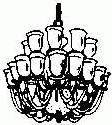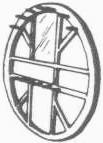Pews
 The pair of pews in the rear of the sanctuary are said to have been used in the first meetinghouse. One has 1728 carved on its back.
The pair of pews in the rear of the sanctuary are said to have been used in the first meetinghouse. One has 1728 carved on its back.
The present pews are numbered ones installed in 1848. An auction was held to sell the earlier pews as a way of paying for the meetinghouse. The people divided the building’s cost into relative prices for the pews and raised more than the total expenses of $5,595 at the sale.
Though the church is carpeted, it is possible to see the wide floorboards in the pews. Small oblong holes in pews 45 and 47 mark the places where the old pews were removed. Gates probably hung across the ends of the pews in the original meetinghouse.
Flemish Chandelier
 The plaque on the right-hand wall of the sanctuary tells of the Flemish chandelier, a gift in 1950 of Miss Abigail and Mr. Charles Bacon, descendants of one of the church’s original members, Jonathan Bacon. The chandelier, minus its present globe shades, had hung for many years at the Boston Architectural Club. Wall sconces on the rear wall match the chandelier and were also Bacon gifts.
The plaque on the right-hand wall of the sanctuary tells of the Flemish chandelier, a gift in 1950 of Miss Abigail and Mr. Charles Bacon, descendants of one of the church’s original members, Jonathan Bacon. The chandelier, minus its present globe shades, had hung for many years at the Boston Architectural Club. Wall sconces on the rear wall match the chandelier and were also Bacon gifts.
Bass Violin
 In the left front corner of the church, mounted on a triangular platform, is a three-string bass viol (restored in 2010 by Volker Nahrmann, converted to four string in 2012 by Dennis Roy), an unusual instrument made by furniture maker, Abraham Prescott, of Concord, NH. Early records mention it having been “put in the care of the elder deacon” around 1810. Another record refers to the bass viol being purchased about 1840 by a member of the parish. Some theorize that, while a more traditional four-string instrument was considered too worldly for sacred music in 1840, the three-string viol with its echo of the trinity, was acceptable. It was used for many years as accompaniment to singers; presently, it is again being played as a part of regular Sunday services. It is slightly larger than the instruments most bassists play today which can require more attention to fingering.
In the left front corner of the church, mounted on a triangular platform, is a three-string bass viol (restored in 2010 by Volker Nahrmann, converted to four string in 2012 by Dennis Roy), an unusual instrument made by furniture maker, Abraham Prescott, of Concord, NH. Early records mention it having been “put in the care of the elder deacon” around 1810. Another record refers to the bass viol being purchased about 1840 by a member of the parish. Some theorize that, while a more traditional four-string instrument was considered too worldly for sacred music in 1840, the three-string viol with its echo of the trinity, was acceptable. It was used for many years as accompaniment to singers; presently, it is again being played as a part of regular Sunday services. It is slightly larger than the instruments most bassists play today which can require more attention to fingering.
Former First Parish string instrument expert (now deceased), Till Shafer, played it many times before its conversion from three to four strings. He commented, “I think it is fair to characterize it as a museum piece.”
South Vestibule
At the right front of the sanctuary is a door which now leads into the South Vestibule; pews once stood in this section and were parallel to the side walls, as on the choir side. The door itself was found in the attic of Dominie Manse, home of the first minister, Mr. Bowes, on the Great Road. This South Vestibule was the office of the church secretary Teddie Evans from the time of the construction of the rear addition in 1960 (Charlotte Evans, her daughter, recalls her mother starting work as secretary in 1965) until the construction of the elevator addition in 1988.
Hook Hasting Organ
 The Hook Hastings pipe organ was added in 1898, it is a fine example of area pipe organs and one that accomplished musicians praise, whether playing it or hearing it! Chief contributor for the organ purchase was Mr. George Hosmer, relative of a Parish Committee member of the period.
The Hook Hastings pipe organ was added in 1898, it is a fine example of area pipe organs and one that accomplished musicians praise, whether playing it or hearing it! Chief contributor for the organ purchase was Mr. George Hosmer, relative of a Parish Committee member of the period.
High Pulpit
 In 1848 the original high pulpit was removed during a remodeling of the interior (probably inspired by the installation of a furnace, along with sealing off the entire second story). Sometime between 1884 and 1898, the low ceiling was taken down and the gallery was separated from the lower floor by a wide ribbon of amber French glass windows. A high pulpit was given to the parish in 1943 by the American Unitarian Association, after it had been removed from a razed church in Ayer. Mr. George Champney, an architect and church member, redesigned the rostrum for the use of a desk and the pulpit, and the area around the organ and pulpit were then paneled to form a harmonious whole. The sounding board above the pulpit is reminiscent of the earlier ornate canopies, and the entire unit looks as if it had always been there.
In 1848 the original high pulpit was removed during a remodeling of the interior (probably inspired by the installation of a furnace, along with sealing off the entire second story). Sometime between 1884 and 1898, the low ceiling was taken down and the gallery was separated from the lower floor by a wide ribbon of amber French glass windows. A high pulpit was given to the parish in 1943 by the American Unitarian Association, after it had been removed from a razed church in Ayer. Mr. George Champney, an architect and church member, redesigned the rostrum for the use of a desk and the pulpit, and the area around the organ and pulpit were then paneled to form a harmonious whole. The sounding board above the pulpit is reminiscent of the earlier ornate canopies, and the entire unit looks as if it had always been there.
The high pulpit was removed as part of the remodeling in 1999. It now resides in Plano, TX, under the loving care of Douglas Morgan Strong (our previous interim minister) and his congregation. Our agreement includes a “right of first refusal”, should the Plano church cease to need it. We can rest assured it will be in good hands!
Silver Communion Service
 The silver communion service, usually on loan to the Museum of Fine Arts in Boston, is periodically back on view. The pieces from left to right: 2 beakers dated 1738, a flagon dated 1811 and two beakers dated 1806. The first communion service of pewter is not known to be in existence, though records of 11/12/1730, speak of contributions used toward the purchase of “1 tablecloth, 2 dishes, 2 pewter tankards, 1 napkin, 1 flagon, and 1 basin.”
The silver communion service, usually on loan to the Museum of Fine Arts in Boston, is periodically back on view. The pieces from left to right: 2 beakers dated 1738, a flagon dated 1811 and two beakers dated 1806. The first communion service of pewter is not known to be in existence, though records of 11/12/1730, speak of contributions used toward the purchase of “1 tablecloth, 2 dishes, 2 pewter tankards, 1 napkin, 1 flagon, and 1 basin.”
Jacobean Chairs
To the left of the high pulpit is the area where today’s choir sits. Once it was part of the congregational seating area, but the old pews were removed during the renovation of 1848. The choir chairs are fittingly elderly for their setting, but the two carved chairs usually placed on the rostrum are well over a hundred years old and are copies of the Jacobean chairs one sees in historic English mansions. They are gifts of Kenneth Blake, a former resident of the Dominie Manse.
Willard Gallery Clock
 On the rear wall, hanging where a long-winded minister might view it and where the congregation might hear it “ping” the hour, is the Aaron Willard gallery clock presented to the church by Jeremiah Fitch on the completion of the new meetinghouse. A twin of this clock hangs in the Harvard Club of Boston on State Street.
On the rear wall, hanging where a long-winded minister might view it and where the congregation might hear it “ping” the hour, is the Aaron Willard gallery clock presented to the church by Jeremiah Fitch on the completion of the new meetinghouse. A twin of this clock hangs in the Harvard Club of Boston on State Street.
Bell Wheel
 The old bell wheel from the tower is currently hanging above the elevator door at the Elm Street entrance. Upon deterioration, it was replaced with a different mechanism. For years it served as a coat rack with pegs and a mirror. When the new meetinghouse opened, rules for the use of the building decreed that “no person shall hang his hat .. on any post or wall .. above the railings of the pews.”
The old bell wheel from the tower is currently hanging above the elevator door at the Elm Street entrance. Upon deterioration, it was replaced with a different mechanism. For years it served as a coat rack with pegs and a mirror. When the new meetinghouse opened, rules for the use of the building decreed that “no person shall hang his hat .. on any post or wall .. above the railings of the pews.”
Teal’s Bible
Between 1822 and 1830, a “late American edition of Teal’s Bible, folio with engravings, bound in English red Morocco and gilt” was presented by Jeremiah Fitch, a Boston merchant who lived in Bedford.
The First Bell
Meremaih Fitch gave the church its first bell for the tower, purchased from England in 1817. Old records show it was used to signal “lecture days,” to toll noon, nine o’clock in the evening, and at funerals when requested.
The New Bell & Clock
The current bell was given in memory of George R Blinn in 1926 and is still hand-pulled on Sunday mornings and at midnight on New Year’s Eve.
The Howard clock was presented by Dudley L Pickman in 1906.
Both the bell and the tower clock are hand-wound and are built into the same frame. The bell is wound twice weekly, and the clock once.
Extracted in part from a brochure prepared for the Bicentennial of the church. The brochure was written by Sarah Getty and illustrated by Lyrl Ahern.
